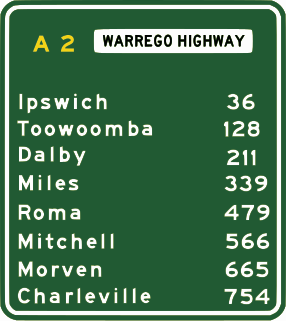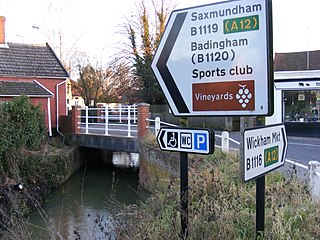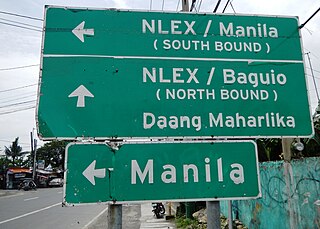Related Research Articles

The International Standard Book Number (ISBN) is a numeric commercial book identifier which is intended to be unique. Publishers purchase ISBNs from an affiliate of the International ISBN Agency.

Traffic signs or road signs are signs erected at the side of or above roads to give instructions or provide information to road users. The earliest signs were simple wooden or stone milestones. Later, signs with directional arms were introduced, for example the fingerposts in the United Kingdom and their wooden counterparts in Saxony.

The Highway Code is a set of information, advice, guides and mandatory rules for road users in the United Kingdom. Its objective is to promote road safety. The Highway Code applies to all road users including pedestrians, horse riders and cyclists, as well as motorcyclists and drivers. It gives information on road signs, road markings, vehicle markings, and road safety. There are annexes on vehicle maintenance, licence requirements, documentation, penalties, and vehicle security.

Jaywalking occurs when a pedestrian walks in or crosses a roadway that has traffic, other than at a suitable crossing point, or otherwise in disregard of traffic rules. The term originated with jay-drivers, people who drove horse-drawn carriages and automobiles on the wrong side of the road, before taking its current meaning.

A limited-access road, known by various terms worldwide, including limited-access highway, dual-carriageway, expressway, and partial controlled access highway, is a highway or arterial road for high-speed traffic which has many or most characteristics of a controlled-access highway, including limited or no access to adjacent property, some degree of separation of opposing traffic flow, use of grade separated interchanges to some extent, prohibition of some modes of transport such as bicycles or horses, and very few or no intersecting cross-streets or level crossings. The degree of isolation from local traffic allowed varies between countries and regions. The precise definition of these terms varies by jurisdiction.

The Manual on Uniform Traffic Control Devices for Streets and Highways is a document issued by the Federal Highway Administration (FHWA) of the United States Department of Transportation (USDOT) to specify the standards by which traffic signs, road surface markings, and signals are designed, installed, and used. These specifications include the shapes, colors, and fonts used in road markings and signs. In the United States, all traffic control devices must legally conform to these standards. The manual is used by state and local agencies as well as private construction firms to ensure that the traffic control devices they use conform to the national standard. While some state agencies have developed their own sets of standards, including their own MUTCDs, these must substantially conform to the federal MUTCD.
Traffic codes are laws that generally include provisions relating to the establishment of authority and enforcement procedures, statement of the rules of the road, and other safety provisions. Administrative regulations for driver licensing, vehicle ownership and registration, insurance, vehicle safety inspections and parking violations may also be included, though not always directly related to driving safety. Violations of traffic code are often dealt with by forfeiting a fine in response to receiving a valid citation. Other violations, such as drunk driving or vehicular homicide are handled through the criminal courts, although there may also be civil and administrative cases that arise from the same violation. In some jurisdictions, there is a separate code-enforcement branch of government that handles illegal parking and other non-moving violations. Elsewhere, there may be multiple overlapping police agencies patrolling for violations of state or federal driving regulations.

In road transport, a yield or give way sign indicates that merging drivers must prepare to stop if necessary to let a driver on another approach proceed. A driver who stops or slows down to let another vehicle through has yielded the right of way to that vehicle. In contrast, a stop sign requires each driver to stop completely before proceeding, whether or not other traffic is present. Under the Vienna Convention on Road Signs and Signals, the international standard for the modern sign is an inverted equilateral triangle with a red border and either a white or yellow background. Particular regulations regarding appearance, installation, and compliance with the signs vary by some jurisdiction.

PSoC is a family of microcontroller integrated circuits by Cypress Semiconductor. These chips include a CPU core and mixed-signal arrays of configurable integrated analog and digital peripherals.
The Rules of the Road is the official road user guide for Ireland.

The Traffic Signs Regulations and General Directions is the law that sets out the design and conditions of use of official traffic signs that can be lawfully placed on or near roads in Great Britain and the Isle of Man. The regulations were the result of the review of British road signage carried out by the Worboys Committee.

A box junction is a road traffic control measure designed to prevent congestion and gridlock at junctions. The surface of the junction is typically marked with a yellow criss-cross grid of diagonal painted lines, and vehicles may not enter the area so marked unless their exit from the junction is clear, or they are intending to turn and are prevented from doing so by oncoming traffic, or other vehicles on the box waiting to turn.
A driver's manual is a book created by the DMV of a corresponding state in order to give information to people about the state's driving laws. This can include information such as how to get a license, license renewal, road laws, driving restrictions, etc. "In the U.S. there is no central organization that is responsible for the creation of Driver's Manuals.". As a result, there is no set of rules for the states to create the manuals, so all driver's manuals vary by state. However, every state does still follow general guidelines when creating the manuals.

The geometric design of roads is the branch of highway engineering concerned with the positioning of the physical elements of the roadway according to standards and constraints. The basic objectives in geometric design are to optimize efficiency and safety while minimizing cost and environmental damage. Geometric design also affects an emerging fifth objective called "livability," which is defined as designing roads to foster broader community goals, including providing access to employment, schools, businesses and residences, accommodate a range of travel modes such as walking, bicycling, transit, and automobiles, and minimizing fuel use, emissions and environmental damage.

Road Users' Code is a road users' guide published by the Transport Department of Hong Kong.

Cycling infrastructure refers to all infrastructure permissible for use by cyclists, including the network of roads and streets used by motorists, except where cyclists are excluded, along with bikeways from which motor vehicles are excluded – including bike paths, bike lanes, cycle tracks, rail trails and, where permitted, sidewalks. Cycling infrastructure also includes amenities such as bike racks for parking, shelters, service centers and specialized traffic signs and signals. Cycling modal share is strongly associated with the size of local cycling infrastructure.

Driving in India is governed by various legal powers and in some cases is subject to the passing of a driving test. The Ministry of Road Transport and Highways, a branch of the Government of India, is the apex body for formulation and administration of the rules, regulations and laws relating to road transport, national highways and transport research, in order to increase the mobility and efficiency of the road transport system in India. Indian traffic drives on the left.
The United Arab Emirates employs minimum and maximum speed limits, which vary for different types of vehicles and roads. The roads are monitored by speed cameras to detect traffic violations such as speeding. Heavy vehicles such as trucks, mini buses and buses are installed with speed limiters to prevent overspeeding. The UAE is notable for having the highest posted speed limits in the world, with two major highways, the Abu Dhabi-Al Ain highway and the Sheikh Khalifa highway, both having limits of 160 km/h (99 mph). Speed limits in the Emirate of Abu Dhabi are generally higher than the other Emirates. The general speed limit in Abu Dhabi is 140 km/h whereas in Dubai it is 110 km/h and in the Northern Emirates its 120km/h. Every Emirate with the exception of Abu Dhabi also has a speed buffer, allowing motorists to drive 20 km/h above the posted speed limit without any fines.

Yellow lines are road markings used in various territories.

Road signs in the Philippines are regulated and standardized by the Department of Public Works and Highways (DPWH). Most of the signs reflects minor influences from American and Australian signs, but keeps close to the Vienna Convention on Road Signs and Signals as an original signatory.